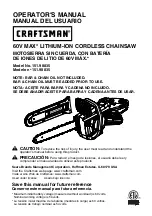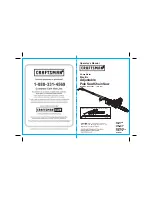
GB
NL
DE
FR
10
6.2 Connection to the mains supply
•
Connect the mains cable to a suitable extension
cable. Make sure that the extension cable is designed
to accommodate the power of the chain saw.
•
Secure the extension cable against tractive forces
and accidental unplugging as shown in (Fig.10).
•
Connect the extension cable to an earthed safety
socket installed in accordance with regulations. We
recommend the use of a cable in a signal colour (red
or yellow). This reduces the risk of accidental damage
from the chainsaw.
Recommendation
Only connect the device to a power source that is pro-
tected via a residual current protective device (RCD) with
a maximum release current of 30 mA.
6.3 Switching on/off
Switching on
•
Hold the chainsaw
with both hands on the hand-
le (thumb under the handle).
•
Press and hold the switch lock (Fig.11).
•
Switch the chainsaw on with the on/off switch (3). The
switch lock (14) can now be released again.
Switching off
•
Release the on/off switch (3). Always pull out the
mains plug when discontinuing the work.
7. Working with the chainsaw
7.1 Preparation
Before each use, check the following to ensure safe
work:
Condition of the chainsaw
Before beginning work, inspect the chainsaw for damage
to the housing, the mains cable, the saw chain and the
guide bar. Never use an obviously damaged machine.
Oil tank
Fill level of the oil tank. Also check whether there is
oil available while working. Never operate the
saw if there is no oil or the oil level has dropped below
the minimum oil level mark in order to prevent damage
to the chain saw. On average, an oil
is
for 10 minutes of operation, depending on the duration
of pauses and the stress.
Saw chain
Tension of the saw chain, condition of the cutters. The
sharper the saw chain is, the easier and more manage-
able the chain saw is to operate. The same applies for
the chain tension. Also check the chain tension at least
once every 10 minutes while working in order to increase
safety! New saw chains, in particular, tend to have a
higher degree of elongation.
Protective clothing
Make absolutely sure to wear the appropriate, close-
protective clothing, such as chainsaw-protective
pants, gloves and safety shoes.
Hearing protection and protective goggles
Wear a safety helmet with integrated hearing protection
and a face guard. This provides protection against falling
branches and recoiling branches.
Attachment of the shoulder belt
1. Wear the shoulder belt so that it lies over the right
shoulder (Fig. 12).
2. Fasten the carabiner hook on the shaft bracket on
the shaft (Fig. 13).
Safe work
•
In order to ensure safe work, a maximum working
angle of 60° is prescribed.
•
Never stand below the branch to be sawed.
•
Exercise caution when sawing branches under tensi-
on or splintering wood.
•
Potential risk of injury from falling branches and
wood projectiles!
•
If the machine is in operation, keep persons and ani-
mals away from the danger area.
•
The machine is not protected against electric shock
when coming into contact with high-voltage lines.
Maintain a minimum clearance of 10 m from current-
carrying lines. Life-threatening danger from electric
shock!
•
When working on an incline, always stand above or to
the side of the branch to be sawed.
•
Hold the machine as close as possible to your body.
By doing so, you maximise your balance.
Sawing techniques
•
When removing branches, hold the machine at an an-
gle ranging from a maximum 60° to horizontal in order
to avoid being struck by a falling branch.
•
Saw off the lower branches on the tree
By do-
ing so, it is easier for the cut branches to fall to the
ground.
•
At the end of the cut, the weight of the saw suddenly
increases for the user, because the saw is no longer
supported on the branch. There is the risk of losing
control of the saw.
•
Only pull the saw out of the cut with the saw chain
running. By doing so, you can prevent it from getting
jammed.
•
Do not saw with the tip of the guide bar.
•
Do not saw into thick the branch formations. This
impedes the tree‘s ability to heal the wound.
Sawing off smaller branches
(Fig.14)
Place the stop face of the saw on the branch. This pre-
vents
movements of the saw at the beginning of the
cut. Applying light pressure, guide the saw through the
branch from top to bottom.
Sawing off larger and longer branches
(Fig.15)
Make a relief cut when sawing larger branches.
a) First saw through 1/3 of the branch diameter from
bottom to top using the top side of the guide bar.











































